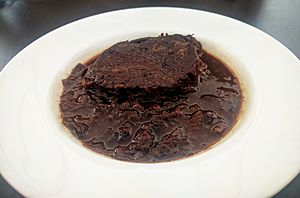Pašticada facts for kids
 |
|
| Alternative names | Dalmatinska pašticada |
|---|---|
| Type | Beef |
| Place of origin | Croatia |
| Region or state | Dalmatia |
| Main ingredients | beef, wine, vinegar, cloves, prunes |
Pašticada is a super special beef dish from Croatia. It's like a pot roast, but way more flavorful! People in Dalmatia, a beautiful region in Croatia, love to eat it at big parties and family get-togethers. It takes a long time to make, but it's totally worth it for the amazing taste.
What is Pašticada?
This dish is made with beef that's cooked slowly in a yummy sweet and sour sauce. It's often called Dalmatinska pašticada because it comes from Dalmatia. The word "braised" means the meat is first seared (quickly browned) and then slowly cooked in liquid. This makes the beef super tender and juicy.
How is Pašticada Made?
Making pašticada is a bit of an adventure! It needs careful steps and lots of time.
- Preparing the meat: First, a big piece of beef, usually from the "eye of round" part, is poked with holes. These holes are then filled with yummy things like garlic, cloves, carrots, and bacon.
- Marinating: After stuffing, the meat soaks overnight in wine vinegar. This step is called marinating, and it helps make the meat tender and adds lots of flavor.
- Cooking the dish: The next day, the meat is quickly browned on all sides. This is called searing. Then, it's slowly cooked for many hours with onions, parsley root, prunes, wine, and a sweet Croatian wine called prošek. This slow cooking, or simmering, makes the meat incredibly soft.
- Finishing touches: Once the meat is cooked, it's sliced into thick pieces. These slices are then put back into the delicious sauce to cook a little more. This helps the meat soak up even more flavor.
How to Serve Pašticada?
Pašticada is usually served with gnocchi (small potato dumplings) or homemade pasta. These sides are perfect for soaking up all the rich, tasty sauce.
History of Pašticada
The exact start of pašticada is a bit of a mystery. However, we know it's a very old recipe! The oldest known recipe for this dish comes from Dubrovnik, a city in Croatia. This recipe dates all the way back to the 1400s, which is over 500 years ago!

